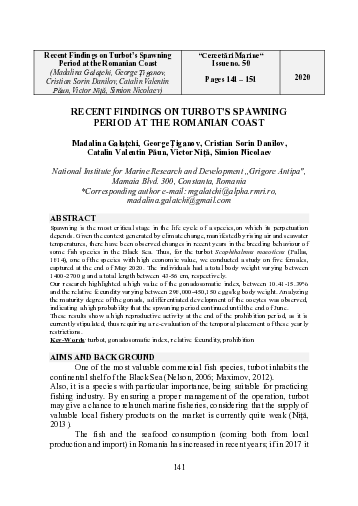Recent Findings on Turbot’s Spawning Period at the Romanian Coast
DOI:
https://doi.org/10.55268/CM.2020.50.141Keywords:
turbot, gonadosomatic index, relative fecundity, prohibitionAbstract
Spawning is the most critical stage in the life cycle of a species,on which its perpetuation depends. Given the context generated by climate change, manifested by rising air and seawater temperatures, there have been observed changes in recent years in the breeding behaviour of some fish species in the Black Sea. Thus, for the turbot Scophthalmus maeoticus (Pallas, 1814), one of the species with high economic value, we conducted a study on five females, captured at the end of May 2020. The individuals had a total body weight varying between 1400-2700 g and a total length between 43-56 cm, respectively. Our research highlighted a high value of the gonadosomatic index, between 10.41-15.39% and the relative fecundity varying between 298,000-450,150 eggs/kg body weight. Analyzing the maturity degree of the gonads, a differentiated development of the oocytes was observed, indicating a high probability that the spwaning period continued until the end of June. These results show a high reproductive activity at the end of the prohibition period, as it is currently stipulated, thus requiring a re-evaluation of the temporal placement of these yearly restrictions.
Downloads
Published
2020-12-20
How to Cite
Galaţchi, M., Ţiganov, G., Danilov, C.-S., Păun, C.-V., Niţă, V., & Nicolaev, S. (2020). Recent Findings on Turbot’s Spawning Period at the Romanian Coast. Cercetări Marine - Recherches Marines, 50(1), 141–151. https://doi.org/10.55268/CM.2020.50.141
Issue
Section
ORIGINAL ARTICLES
License
This is an open access journal, which means that all content is freely available without charge to the user or his/her institution. Users are allowed to read, download, copy, distribute, print, search, or link to the full texts of the articles, or use them for any other lawful purpose, without asking prior permission from the publisher or the author. This is in accordance with the BOAI definition of open access.






